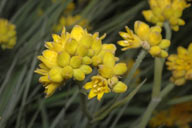In Flower This Week
A news sheet prepared by a Gardens' volunteer.
Numbers before each plant refer to temporary IFTW labels in the gardens.
Numbers in square brackets [ ] refer to garden bed Sections. Plants in flower are in bold type.
View past issues of 'In Flower This Week'.
29 October 2014
Conostylis candicans subsp. candicans click for larger image |
There are so many plants in flower at this time that it is hard to choose which ones to feature.
- As you leave the Visitor Information Centre look to your left to see Dendrobium × delicatum [Section 212], an orchid with clusters of white flowers and oblong green foliage. This lithophyte (a plant that grows on rock) is native along the Great Dividing Range in south east Queensland.
- On your right in a pot is Gastrolobium involutum [Section 221], with bright orange/yellow pea flowers on graceful fine linear foliage. It occurs naturally in a restricted area near Esperance, Western Australia.
- Further on your right in a pot is Swainsona formosa [Section 221], or Sturt’s Desert Pea, with pale green leaves and bright red pea flowers. The flowers have shiny black centres or bosses. This iconic plant is named after English botanist Isaac Swainson.
- Notice in a pot on your right Hibbertia stellaris [Section 174], or Orange Stars, with masses of orange star flowers on wiry foliage. This brilliantly flowering ground cover from south Western Australia grows naturally in swamps.
- In a small bed on your right before crossing the bridge are clumps of Conostylis candicans subsp. candicans [Section 174], with yellow flower-heads on fine grey strappy foliage. This plant is endemic to Western Australia.
- Look high on your left to see Vesselowskya rubifolia [Section 210], a large shrub with serrated green leaves and fluffy racemes of pink and cream flowers. This plant has a restricted distribution in rainforest in eastern New South Wales. The common name is Mountain Marara or Dorrigo Southern Marara.
- As you cross the bridge notice on your right Olearia argophylla [Section 66], a tall shrubby daisy with many white flower-heads with gold centres. Also called Native Musk, the flowers are strongly scented and the grey leaves felted with hairs. It is an east coast plant which grows naturally in New South Wales, Victoria and Tasmania.
- Pimelea ferruginea ‘Magenta Mist’ [Section 131], on your left in the Ellis Rowan Garden, has bright pink flower-heads on neat foliage.
- On your right towards the top of the hill is Homoranthus flavescens [Section 9] with acid yellow blooms layered on a small bush. There is a pretty contrast between the flowers and the fresh green foliage.
- Melaleuca diosmifolia [Section 9], on your right, has green brush-like flowers on neat darker green foliage.
- Look up to your left to see one of the most spectacular flowers in the Gardens. Doryanthes excelsa [Section 8], or Gymea Lily, is found only in coastal areas near Sydney, New South Wales. It has sword-like leaves more than a metre long and flower spikes that grow 2-4 metres high.
- Telopea ‘Canberry Gem’ [Section 30], also on your left, forms another spectacular display. Bright pink/red waratah flower-heads cover a large bush, which has dark green foliage.
- Close by on your left is another waratah Telopea mongaensis [Section 30], a smaller bush with deeper red flowers, commonly known as the Monga Waratah or Braidwood Waratah. It grows at high altitude in south eastern New South Wales.
- Turn back now and veer right to see Pultenaea villosa [Section 30] on your right. This tall scraggly bush has tiny neat foliage and egg-yolk yellow pea flowers with red centres.
- Also on your right is Bauera rubioides [Section 8], or Dog Rose, a large bush with bright pink flowers en masse.The species is widespread throughout coastal and in moist mountain areas in New South Wales, Victoria and Tasmania.
Rosalind Walcott
![Director of National Parks [logo]](../../../../images/dnp_90px.gif)







